
|
|
|
|
|
|
CONTACT US |
|

 |
|
||||||||||||
 |
|||||||||||||
|
|
Dennis Charles Hannah, a quarter Cherokee Citizen born in Adair County Oklahoma on August 12, 1920 and a graduate of Muskogee High School was inducted into the United States Army on the day before his 22nd birthday, August 11, 1942. He entered basic training at Camp Walters, Texas near Mineral Wells and was qualified as weapons armor with expert ratings in rifle, pistol, and machinegun. He volunteered for the newly formed airborne service and departed Camp Walters on December 2, 1942 for training at Fort Benning, Georgia. Hannah completed his airborne instruction and qualifying jumps receiving his diploma as a parachutist and airborne wings on January 9, 1943. He received advanced training in infantry tactics and completed demolition school in January of 1943. Hannah was assigned to active duty as a parachutist with E Company of the 505th Parachute Infantry Regiment, (505th PIR) .
The regiment departed Fort Benning for additional training and maneuvers at Fort Bragg North Carolina on February 12, 1943. Upon its arrival the 505th PIR became of the 82nd Airborne Division. The 82nd had recently been brought out of retirement and newly designated as airborne. It consisted of two parachute regiments, the 505th and the 504th PIRs; one glider regiment, the 325th GIR; and supporting artillery, engineer, medical, anti-aircraft and other units. General Matthew B. Ridgway served as the commanding general. Extensive training, maneuvers, and specialist instruction was provided at Fort Bragg in preparation for the division’s deployment overseas. Hannah’s unit began its move overseas via Camp Edwards on Cape Cod in Massachusetts, thence by train to New York where it boarded the Matson Liner, USS Monterey for transport overseas. The Monterey, a passenger ship converted to a troop transport sailed from New York Harbor on April 29, 1943. The 505th PIR, as part of the 82nd Airborne Division, landed in Casablanca on May 10, 1943. From there the regiment moved from Casablanca, Morocco to the small Arab town of Oujda, just west of the Algerian border and about 30 miles south of the Mediterranean Sea. Here the division continued its training, eventually making their final move to bivouac sites in Tunisia for the assault on Sicily.
Hannah was selected to be part of a hand-picked platoon assigned to jump ahead of the division with a mission secure a key bridge near Camerian. This unit was segregated from the main company for special training and briefing on the assignment prior to the assault. Due to the isolation from the main body of troops, the platoon became known as the “Bastard Platoon”; a designation that would stick with Hannah’s 2nd Platoon of the E Company for the reminder of the war. This platoon was repeated called upon for special assignments and operations throughout the 750+ days of combat Hannah served with the 82nd during WWII. The platoon took off for Sicily on the night of July 9, 1943 as part of the first airborne invasion of WWII. The 505th PIR was pitted against the Hermann Goering panzer Division and was able to establish itself as a superb combat infantry unit. Sicily ended for the 82nd by the third week of July and by early September the division was making preparation for its second combat jump into Italy. Hannah’s unit parachuted into the Slerno Bay area to reinforce the Fifth Army which as having difficult time in the Salerno amphibious landing. With the seizure of Naples on October 1, 1943, the 82nd moved north to the Volturno River. Hard fighting, negotiation of difficult terrain and a case of malaria describes Hannah’s combat role in the Italian Invasion. By late fall the 82nd was withdrawn from the Volturno campaign and redeployed, first to Belfast, Ireland and later to Leicester, England in preparation for the Normandy Invasion. Dennis Hannah’s jump wings displayed two stars signifying his combat jumps when he parachuted in Normandy prior to the beach landings on June 6, 1944. As part of the 2nd Battalion, Hannah’s company was positioned to the north of Ste. Mere Eglise to protect the division’s airhead. He participated in fierce fighting to capture and hold the Merdert River Bridge and was with the combined operation with seaborne troops to capture the Montebourg Station. It was Dennis Hannah who led a squad level attack that seized and knocked out a German 88mm, three gun artillery battery firing on the Utah Beach-head. He would later be awarded the Bronze Star for Valor by his gallantry, heroism, and leadership in that engagement. On June 13th while fighting in the drive to the Quineville-Montebourg-Le Ham ridge, Hannah was wounded by shrapnel and evacuated from the battlefield to Utah Beach and returned to England. The shrapnel, lodged in his right arm bone was unable to be removed and was left in place. He was later awarded the Purple Heart for wounds received in the Normandy Invasion.****(During a medical procedure in 1997, an x-ray at the OU Medical Center revealed that the shrapnel was still embedded in his upper arm bone. When questioned by his doctor as to what the object was, Hannah simply replied “that is a souvenir I brought home from the war”.)
Fully recovered, Hannah rejoined his unit in time to participate in the daylight combat jump into Holland on September 17,1944 as a part of Operation Market-Garden; the largest airborne invasion during WWII. The airborne component of the invasion (code named “Market”) was a bold initiative conceived by British General Montgomery to initiate combined air assaults of the newly formed 1st Allied Airborne. Composed of U.S. 82nd and 101st Airborne Divisions along with 1st Airborne, air landings were to capture a series of key bridges, opening a corridor for the British Royal Guards Armored Division to capture the key city of Antwerp. Hannah participated in the capture of the Meuse River Bridge at Grave and was one of 300 airborne troopers who executed what General Gavin later described as “the most masterfully executed infantry maneuver of World War II” in capturing the Rhine (Waal) River Bridge at Nijmegen. Hannah led the 2nd Platoon in the initial assault on the German fortified Roundabout at the Nijmegen bridgehead. Although Operation Market-Garden did not achieve its full objective of penetrating into the German homeland, the engagement was a proving ground for the importance and striking strength of airborne and air-landing units. E Company of the 505th PIR was later awarded the Presidential Unit Citation for its part in securing the key bridge at Nijmegen. After two months of heavy fighting, Hannah’s unit left Holland and in late November moved back to France to get replacements, maintain weapons and equipment, and to undertake intensive training in preparation for the invasion of Germany.
Hannah’s furlough to Paris in late December of 1944 was cut short by the massive German counter offensive in the Ardennes region of Belgium. With over 20 divisions moving on a broad front, the German Army broke allied defenses capturing large numbers of American soldiers, equipment, and territory. The 505th PIR was called into action and immediately moved in the direction of the German breakthrough. Hannah’s unit passed through Bastogne and then north to Werbomont. At daylight on December 18, 1944 E Company was deployed at Trois Ponts near Malmedy; site of the slaughter of American prisoners by the German ZZ. Now a Tech-Sergeant, Hannah’s platoon was assigned as the point unit above the Trois Ponts rail yards. Within minutes of establishing a machinegun position along the main road in a heavily wooded area, Hannah identified several soldiers moving through the forest directly across the road from his position. While the soldiers were wearing captured U.S. overcoats, Hannah was able to discern the distinctive silhouette of the Germans’ helmets and gave the order to open fire on the approaching enemy. What at first appeared to be a platoon strength engagement soon revealed that this was the lead unit of the 1st Regiment of the 1st Panzer Division. Hannah’s unit was soon engaged in close quarters combat and hand-to-hand fighting. With his squad suffering several casualties and exhaustion of munitions, Hannah gave the order to withdraw with the remaining members of his unit barely escaping through the cover of rail cars in the railroad marshaling yard. Finally rejoining the remainder of the 505th PIR which had taken up positions on the banks of the Salm River in the town of Trois Ponts Hannah’s regiment stalled the advance of over one hundred enemy tanks and supporting infantry of the Panzer Division. Hannah spent Christmas Day of 1944 digging a foxhole in the frozen ground during heavy snowfall. As the German counter offensive stalled, Hannah’s unit participated in a counteroffensive that drove the Germans back into the Siegfried Line. The 505th PIR continued fighting through the Huertgen Forest before finally being taken out of the line in late February of 1945.
After return to France for re-equipping, the 82nd was later redeployed to Cologne, Germany. Hannah was part of the amphibious assault that crossed the Elbe River 30 miles south of Hamburg. Following the Elbe crossing, Hannah was taken from the line and returned to Division HQ and offered a Battlefield Commission as a Second Lieutenant. When told that he would have to be transferred out of his company if he accepted, he respectfully refused the commission and returned to the unit that he had served with since landing North Africa.
The 82nd continued to move deeper into Germany and liberated the prison camp at Wobelien. With enemy resistance beginning to wane, increasing numbers of surrendering Germans, and the first sighting of Russian Army units, Hannah’s company was within 60 miles of Berlin when word came down the line that the war was over and that they were to stop all advance. Assignments following the cession of combat took on a variety of unique assignments. Hannah’s “Bastard Platoon” was called upon to serve as the transfer guard for Nazi death camp officers to the British Army. E Company was also tagged with the securing of a “displaced persons” compound before the entire division prepared to move on to Berlin for occupation duty.
Talk of the 82nd being withdrawn for redeployment to the Pacific Theater to jump in the anticipated invasion of Japan ended with the dropping of the atomic bomb and the surrender of Japan in August of 1945. By now Hannah had more than sufficient “combat points” to return state-side for discharge. Departing France on September 7, 1945, he arrived in New York harbor on September 15, 1945 and received his honorable discharge at Camp Chaffee, Arkansas on September 23, 1945 thus ending a combat service of just over 3 years.
He would continue to serve in the U.S. Army Reserve until September of 1948.
For his service in the U.S. Army, Sgt. Dennis C. Hannah received:
Foreign Honors/Decorations awarded:
Company E, 505th PIR Decorations:
(Bio courtesy of Jay Hannah, his son)
Private First Class Dennis C. Hannah.
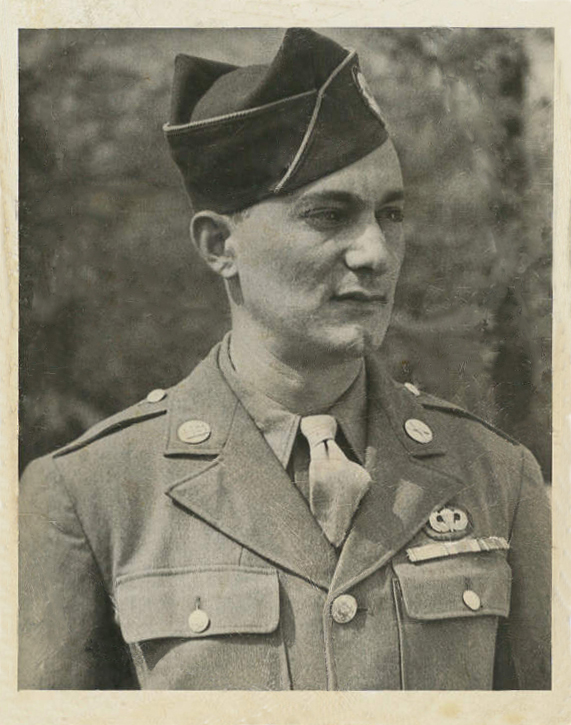
Private Dennis Hannah with new jump wings.
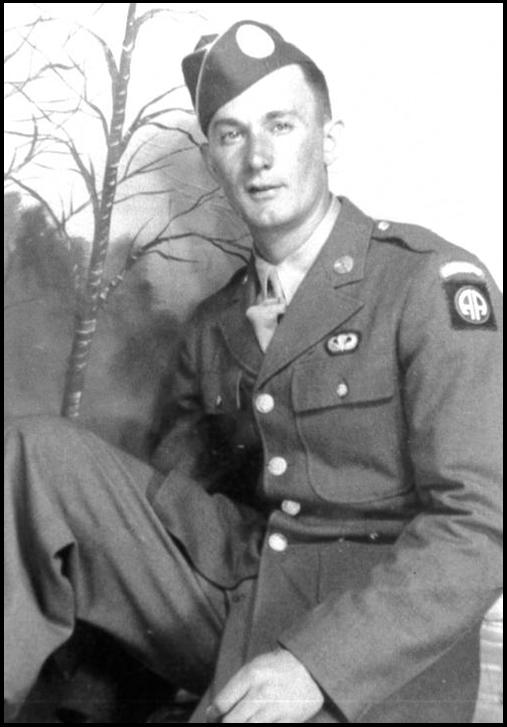
505 in Camp Quorn, England 1944.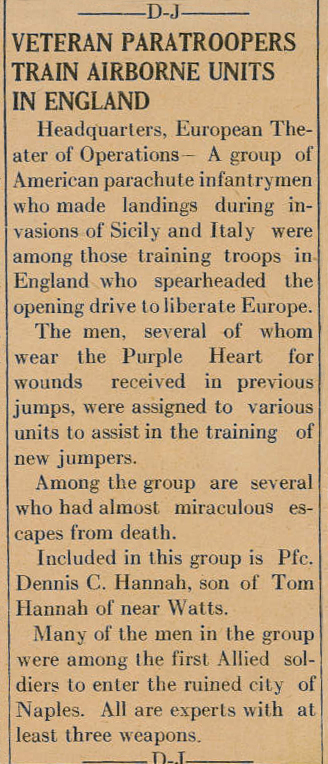
Break time, Dennis Hannah on right.
Pfc. Dennis Hannah awarded the Bronze Star medal.

Hurtgen Forest, Germany 1945.
R.J. Mueller on left, Dennis Hannah right with Thompson machine gun .
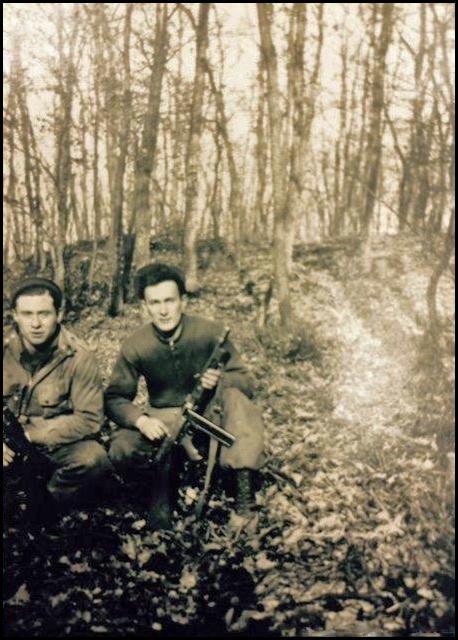
.
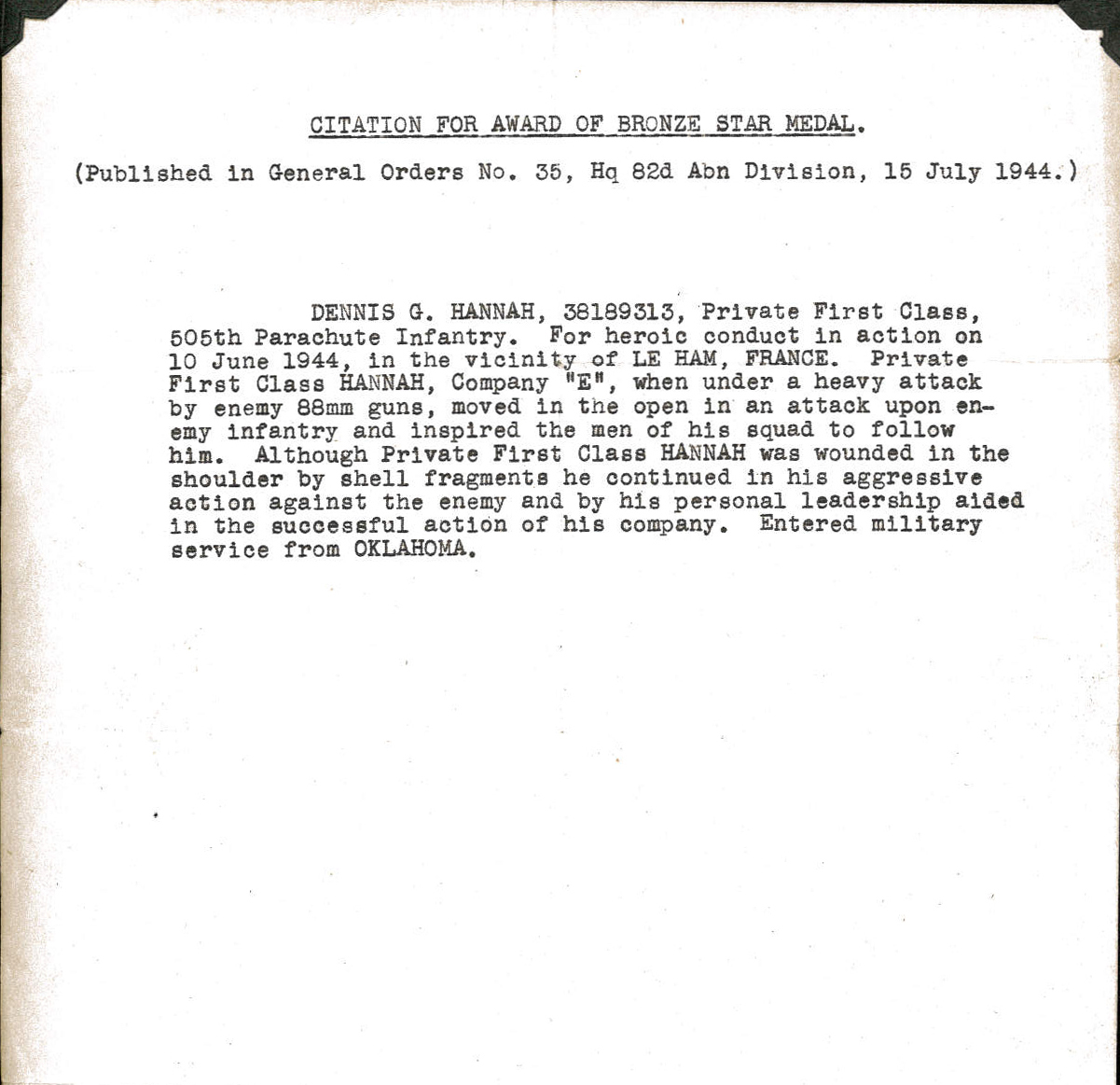

|
|